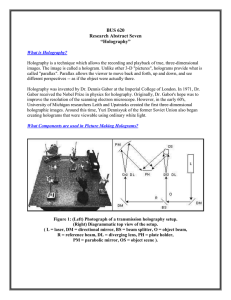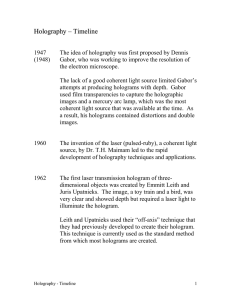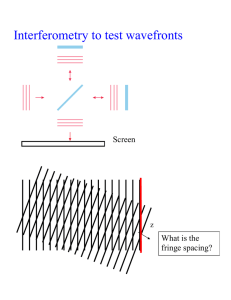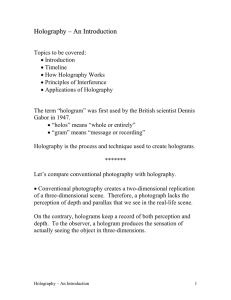Holographic Imaging of Atomic Structure:
advertisement
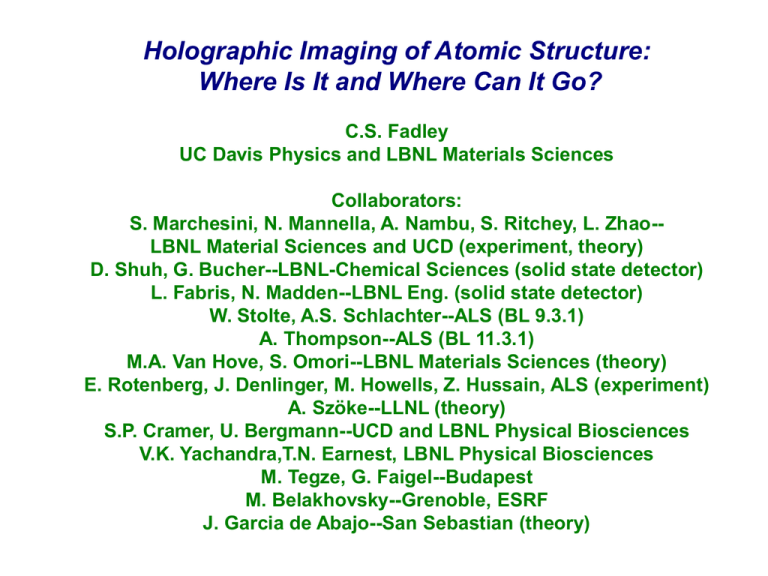
Holographic Imaging of Atomic Structure: Where Is It and Where Can It Go? C.S. Fadley UC Davis Physics and LBNL Materials Sciences Collaborators: S. Marchesini, N. Mannella, A. Nambu, S. Ritchey, L. Zhao-LBNL Material Sciences and UCD (experiment, theory) D. Shuh, G. Bucher--LBNL-Chemical Sciences (solid state detector) L. Fabris, N. Madden--LBNL Eng. (solid state detector) W. Stolte, A.S. Schlachter--ALS (BL 9.3.1) A. Thompson--ALS (BL 11.3.1) M.A. Van Hove, S. Omori--LBNL Materials Sciences (theory) E. Rotenberg, J. Denlinger, M. Howells, Z. Hussain, ALS (experiment) A. Szöke--LLNL (theory) S.P. Cramer, U. Bergmann--UCD and LBNL Physical Biosciences V.K. Yachandra,T.N. Earnest, LBNL Physical Biosciences M. Tegze, G. Faigel--Budapest M. Belakhovsky--Grenoble, ESRF J. Garcia de Abajo--San Sebastian (theory) Direct or Inside-Source Holography Hologram Detector (scanned) Reference wave Emitted source wave Scattered Exciting beam object/subject waves Emitter = “inside source” Scattering centers: atoms, nuclei Exciting beam Emitted source wave X-ray/Electron Auger electron (Tonner) X-ray Photoelectron (Szöke, Barton) X-ray Fluorescent x-ray (Tegze, Faigel) Electron Incoherently scattered/ Kikuchi electrons (Saldin, de Andres) Electron Bremsstrahlung x-ray + filter (Sorensen et al.) Inverse or Inside-Detector Holography Neutron scattered Exciting beamIncoherently Emitted detected neutrons (from protons) = source wave wave (Sur et al.) X-ray Fluorescent x-ray Detector (fixed) Emitted detected wave Gamma ray/X-ray Conversion e(nuclear resonance) or gamma ray Neutron (nuclear excitation) Emitter = “inside detector” Scattered object/subject waves Gamma ray The basic imaging ideas: (Gabor; Helmholtz-Kirchoff; Wolf; Szöke; Barton-Tong) I( k ) k 3D sampled region O I( k ) Φref ( k ) Φobj ( k ) 2 2 The hologram Weak, isotropic scattering Φref ( k ) Φref ( k )Φobj ( k ) Φref ( k )Φobj ( k ) Φobj ( k ) * * I( k ) I0 I( k ) Φref ( k ) Ho log ram : χ( k ) 2 I0 Φref ( k ) Ho log raphic image : U( r ) χ( k )exp[ ik 3 r ikr ]d k 2 2 2 (No phase problem!) Inside-Source Holography with Thermal Neutrons Inside-Source Neutron Hologram Al4Ta3O13(OH) + Bragg peaks Sur et al. Nature 414, 525 (2002) ΔI 0.5% I O-atom holographic Image-Centered on H Direct or Inside-Source Holography Hologram Detector (scanned) Reference wave Emitted source wave Scattered Exciting beam object/subject waves Emitter = “inside source” Scattering centers: atoms, nuclei Exciting beam Emitted source wave X-ray/Electron Auger electron X-ray Photoelectron X-ray Fluorescent x-ray Electron Incoherently scattered/ Kikuchi electrons Electron Bremsstrahlung x-ray + filter Neutron Inverse or Inside-Detector Holography Incoherently scattered neutrons (from protons) Exciting beam = source wave Detector (fixed) X-ray Emitted detected wave Emitter = “inside detector” Emitted detected wave Fluorescent x-ray (Gog et al.) Gamma ray/X-ray Conversion e(nuclear resonance) or gamma ray (Korecki et al.) Scattered object/subject waves Neutron (nuclear excitation) Gamma ray (Cser et al.) Inside-Detector Holography with Gamma Rays & Resonant Scattering Resonantly scattering nucleus Far-field gamma source e- Horizontal Emitting nucleus Hologram--Fe epitaxial film ΔI 2% I Vertical Korecki et al. PRL 79, 3518 (1997) Images Photoelectron and x-ray fluorescence holography: (a) Inside-source holography (direct, XFH): Scattering atom Detector (small solid angle) ALS und. hnexcit beamlines Exciting 4.0.2, 7.0.2 x-rays Emitting atom (b) Inside-detector holography (inverse, MEXH): Scattering atom Object Detector (large solid angle) hnfluor Emitting atom ALS b.m. Exciting beamlines x-rays 9.3.1 11.3.1 superbend? Scattering of x-rays and electrons : X-ray scattering from Ni (+Thomson + resonant effects) |f0()| |0()| Electron scattering from Ni |f()| |()| Inside-source - PH: W 4f7/2 photoelectron spectra Two site-specific holograms Inside-source - PH: Len et al. PRB 59, 5857 (1999) Images centered on surface W atom Len et al. PRB 59, 5857 (1999) Inside-detector XFH: can be multi-energy “MEXH” Fe K ΔI 0.5 % I 3 energies Images of Fe2O3 Gog et al. PRL 76, 3132 (1996) Expt. Theory Inside-source XFH: Fe K hologram bcc Fe Symmetrized image 2 energies-K & K Kossel lines ΔI 0.3 0.5 % I Hiort et al. PRB 61, R830 (2000) e Inside-detector XFH: Zn (0.02%) in GaAs Zn K 2-energy image centered on Zn dopant Hayashi et al., PRB 63, 041201 (2001) Zn K hologram, 9.7 keV Some ideas to improve holographic images: Derivative photoelectron holography: Taking differences of intensity to yield logarithmic derivative of I(k), then reintegrate: reduces noise/uncertainty in data (Chiang et al., PRL 81, 4160, (1998)) Photoelectron holography: As and Si emission from As/Si(111): U( r ) χ( k )exp[ ik with χˆ 3 r ikr ]d k 2 I( k ) I0 I0 and I( k ) from int egration of log arithmic derivative I( hν δ , kˆ ) I( hν δ , kˆ ) ˆ L( hν , k ) , I( hν δ , kˆ ) I( hν δ , kˆ ) δ I( k ) I( k , kˆ ) A L( hv , kˆ )d 3 k Luh, Miller, Chiang, PRL 81, 4160 (1998) Some ideas to improve holographic images: Derivative photoelectron holography: Taking differences of intensity to yield logarithmic derivative of I(k), then reintegrate: reduces noise/uncertainty in data (Chiang et al., PRL 81, 4160, (1998)) Near-node photoelectron holography: Working near the node of the differential cross section: suppresses forward scattering,improves, images (Greber et al., PRL 86, 2337 (2001)). Forward scatt. Near-node photoelectron holography: Al 2s emission from Al(111) Image around average Al emitter Differential cross section Wider et al. PRL 86, 2337 (2001) e Some ideas to improve holographic images: Derivative photoelectron holography: Taking differences of intensity to yield logarithmic derivative of I(k), then reintegrate: reduces noise/uncertainty in data (Chiang et al., PRL 81, 4160, (1998)) Near-node photoelectron holography: Working near the node of the differential cross section: suppresses forward scattering,improves, images (Greber et al., PRL 86, 2337 (2001)). Differential photoelectron holography: Transforming instead of : also solves the forward scattering problem (Omori et al., PRL 88, 055504 (2002)). Normal hologram k F j exp[ ikrj ik r j ] c.c. (Fj = strength of jth scatterer) j Differential hologram k k k k k k 2 F jeff k exp ikrj ik r j c.c. j k F k F j exp i r j ikˆ r j 2 eff j Differential PH (k 0.1 Å-1) 0 k ˆ 2iF j k sin 2 r j ik r j 0 (a) k=4.6Å-1 (81eV), k = 0.2Å -1 ( E = 7 eV) f 180o back =0o fwd. f eff (b) k=8.8Å-1 (295eV), k = 1.0Å -1 ( E = 67eV) f 180o back =0o fwd. f eff Differential photoelectron holography: normal and effective scattering factors for Cu Cu 3p-Cu(001)-differential holography 6 6 emitter 4 4’ 3 [001] z (Å) 2 e 4’ 4 3 2 [100 ] x ( Å) 1 2’ A 1 2’ Å) [010 ] y ( Differential photoelectron holography: imaging of back, side, (and fwd.) scattering atoms (Omori et al., PRL 88, 055504 (’02) and animations at http://electron.lbl.gov/marchesini/dph) Some ideas to improve holographic images: Derivative photoelectron holography: Taking differences of intensity to yield logarithmic derivative of I(k), then reintegrate: reduces noise/uncertainty in data (Chiang et al., PRL 81, 4160, (1998)) Near-node photoelectron holography: Working near the node of the differential cross section: suppresses forward scattering,improves, images (Greber et al., PRL 86, 2337 (2001)). Differential photoelectron holography: Transforming instead of : also solves the forward scattering problem (Omori et al., PRL 88, 055504 (2002)). Spin-polarized photoelectron holography: Transforming spinsensitive instead of : should permit imaging short-range magnetic order (Kaduwela et al. PRB 50, 9656 (1994)) Simulation: MnO-AF cluster Spin-polarized photoelectron holography: direct imaging of magnetic moments in 3D: Normal image- U r χ k exp ik r ikr d 3 k 2 Spin-selective imagesΔ r U r U r Δ' r exp ik r k exp ikr χ k χ k d 3 k k̂ Kaduwela et al. , Phys. Rev. B 50, 9656 (1994); Fadley et al., J. Phys. B Cond. Matt. 13, 10517 (2001) Photoelectron holographyAdvantages: Element-, chemical state-, and spin- specific local structure Long-range order not required Large % effects, easy to measure Surface sensitive, if that’s what you want Avoids false minima in structure searches Disadvantages: Strong scattering leads to multiple scattering (but can be suppressed by multi-energy datasets) Not bulk sensitive, if that’s what you want Future prospects and instrumentation issues: --Present status Detectors not fast enough/linear enough to handle “snapshot” spectra (cf. ALS project) ALS GHz-RATE 1D DETECTOR 768 channels, 48 spacing, >2 GHz overall Protective shell Microchannel plates 768 collector strips Ampl./Discr. (CAFE-M) Counter/ digital readout (BMC) Ceramic substrate Spring clamps for circuit board and MCP cover Photoelectron holographyAdvantages: Element-, chemical state-, and spin- specific local structure Long-range order not required Large % effects, easy to measure Surface sensitive, if that’s what you want Avoids false minima in structure optimization Disadvantages: Strong scattering leads to multiple scattering (but can be suppressed by multi-energy datasets) Not bulk sensitive, if that’s what you want Requires at least short-range repeated order Future prospects and instrumentation issues: --Present status Detectors not fast enough/linear enough to handle “snapshot” spectra (cf. ALS project) Scanning of sample angles not fast enough --Future possibilities Much faster multichannel detectors up to GHz range Faster scanning of angles via snapshot mode “Tiling” of hemisphere with analyzers to reduce angle scanning XFH at ESRF: Focal spot Sample Graphite analyser j K Detector Graphite analyzer Graphit e analyser K 2f SR Beam Marchesini, Tegze, Faigel et al., Nucl. Inst. & Meth. 457, 601 (2001) X-RAY FLUORESCENCE HOLOGRAPHY AT ESRF--SOME HIGHLIGHTS (Marchesini, Tegze, Faigel et al.) Imaging light atoms: Nature 407, 38 (2000) Imaging a quasicrystal: Phys. Rev. Lett. 85, 4723 (2000) O around Ni in NiO ~150 O and Ni atoms imaged method works without true periodicity neighbours around Mn in MnAlPd image of average atomic distribution Ni K Hologram Mn K Hologram Image Image Al.704 Pd.210Mn.086 Quasicrystal ESRF--S. Marchesini et al. Phys. Rev. Lett. 85, 4723 (2000) First ALS Holograms Pd L Mn K Hologram First application of hard x-ray holography to complex system Structural information in direct space without any assumed model Bragg spots Future data Reconstruction Environments around both Mn and Pd imaged Data at many energiesextended range of imaging More precise atomic environments in the first 5–6 coordination shells, evidence for inflation Rigorous test of theoretical models Sample edge Mn K Samples: P. Thiel P. Canfield X-RAY FLUORESCENCE HOLOGRAPHY AT THE ALS Future plans (a) Experimental setup: (Marchesini et al.) Motion PC Motion Drivers Clock j •Sample heating/coolingphase-transition studies High speed motionacquisitiond/dt = 3600o/sec •Applications to: strongly correlated materials (CMR high-T phases), magnetic quasicrystals (RE-Mg-Zn--I. Fisher), bio-relevant crystals d/dt = Acquisition Acquisition 2o/sec Ge solid state det.- up to 4MHz Monochromatic x-rays (b-e) First data (c) Calc. ALS (d) Mn-atom image (scales in Å) MnO (100) (b) Expt. •Development of: -Resonant and dichroic XFH -More efficient pixel detectors 6 CMR: (La,Sr)3Mn2O7 (e) Expt. 1 (a.u.) F.T. (La, Sr) Mn -6 0 -6 Å 6Å O Jahn-Teller distortions probed with x-ray fluorescence holography: new insights on the CMR effect? La1-xAxMnO3 , A = Ca, Sr , Ca Cubic Orthorhombic LaMnO3 shows long range Jahn-Teller distortions (JT) 2.15 1.92 When x > 0, one theory predicts the coupling of the itinerant electrons with local, short-range JT dist. in the T > Tc insulating phase Key to CMR effect? Schematic view of the tetragonal Jahn-Teller distortions in the ab plane Some ideas to improve holographic images: Derivative photoelectron holography: Taking differences of intensity to yield logarithmic derivative of I(k), then reintegrate: reduces noise/uncertainty in data (Chiang et al., PRL 81, 4160, (1998)) Near-node photoelectron holography: Working near the node of the differential cross section: suppresses forward scattering,improves, images (Greber et al., PRL 86, 2337 (2001)). Differential photoelectron holography: Transforming instead of : also solves the forward scattering problem (Omori et al., PRL 88, 055504 (2002)). Spin-polarized photoelectron holography: Transforming spin-sensitive instead of : should permit imaging short-range magnetic order (Kaduwela et al. PRB 50, 9656 (1994)) Resonant x-ray fluorescence holography: Taking difference holograms above and below a core-level resonance on atom A, and imaging on again,with weighting wk= +1 below resonance and -1 above resonance, and (below) and (above) calculated at three energies below, on, and above resonance, yields images in which only atom A is prominent. RESONANT X-RAY FLUORESCENCE HOLOGRAPHY: A theoretical study (cf. Van Hove talk) Optical constants for Fe and Ni through the Ni K(1s) edge Normal hologram k F j exp[ ikrj ik r j ] c.c. j Differential hologram k k k k k k 2 F jeff k exp ikrj ik r j c.c. j k F jeff k F j exp i r j ikˆ r j 2 2iF k Differential PH (k 0.1 Å-1) 0 j k ˆ r sin r i k j j 2 0 Resonant inverse XFH (k 0.01 Å-1) Resonant atom f1+if2 0 Non-resonant atom 0 0 Resonant x-ray fluorescence holography (a) (b) MEXH--Fe & Ni Fe1 Ni1 Fe2 Fe1 (c) RXFH--Fe suppressed Ni1 Ni1 Fe2 (d) MEXH--Fe & Ni Fe1 Ni1 Fe2 (e) RXFH--Fe suppressed Ni1 Omori et al., PRB 65, 014106 (2002) FeNi3: Structure and simulated holographic images in normal inverse (MEXH) and resonant (RXFH) modes Resonant X-Ray Fluorescence Holography Measuring Cd x-ray holograms above and below the Te L3 edge from CdTe Te L3 Absorption Coefficient (in e-) Photon energy (keV) 1 14 4 12 Identification of nearneighbour scatterers, ‘true color’ holography. 4 3 10 8 6 4 1-2=a a 1 2 4-2=b 2 4.0 4.2 2 4.4 3 4.6 4.8 b CdTe structure Some potential applications of x-ray holography: source or detector site source or detector site average source/ detector site average source/ detector site source or detector site Identify via resonant XFH? average source/ detector site source or detector site Identify via resonant XFH? average source/ detector site …and ultimately more dilute species: source or detector site Active sites in biorelevant molecules average source/ detector site source or detector site source or detector site average source/ detector site average source/ detector site X-ray fluorescence holographyAdvantages: Element-specific local structure Weak scattering, better holographic imaging Long-range order not required Mosaicity up to few degrees OK Avoids false minima in structure optimization With resonance, near-neighbor identification? With CP radiation, short-range magnetic order imaging? Disadvantages: Small % effects, need approx. 109-1010 counts in hologram Requires at least short-range repeated order X-ray fluorescence holographyFuture prospects and instrumentation issues: --Present status Detector-limited--e.g., graphite crystal plus avalanche photodiode (ESRF); Ge detectors up to 1 MHz over 4 elements (LBNL)hologram in approx. 1-10 hours --Future possibilities "Tiling" of hemisphere with Ge detectors ala Gammasphere, Si drift diodes (HASYLAB, Materlik et al.?, commercial sources Ketek and Photon Imaging?) --Future “dream machine” 1 angular resolution, 100 eV resolution for x-rays at 6-20 keV, hemisphere coverage, 1-100 GHz overallhologram in 0.1-10 sec, or in one LCLS pulse E.g., the LBNL Gammasphere: Why not! 110 large volume, highpurity germanium detectors The End
